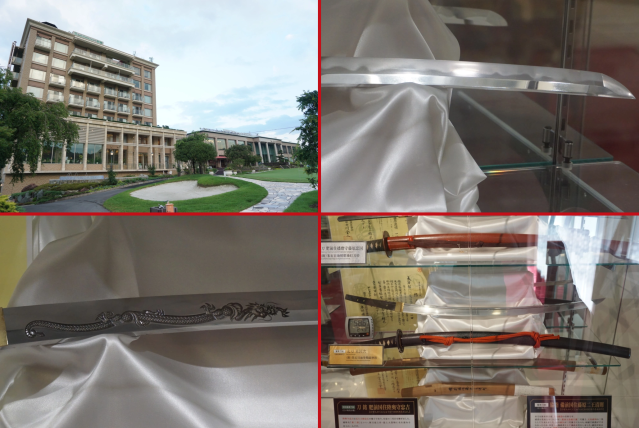
Centuries of samurai history are on display, and we’ll teach you what to look for in appreciating the beauty of a Japanese sword.
If you want to see Japanese swords and armor, and you don’t happen to have a time machine, usually you’ll need to head to a museum. However, we recently came across an astounding collection of katana not in any museum, gallery, or other dedicated cultural facility, but inside a hotel.
Granted, the Hotel Tado Onsen, in the Mie Prefecture town of Kuwana, is a particularly nice hotel, enough so to earn three Michelin guide stars. But while there’s plenty of contemporary luxury to be enjoyed, on our visit we spent most of our time in the hotel’s banquet and meeting rooms, three of which house an amazing assortment of authentic samurai equipment.
To reiterate, these aren’t modern replicas. For example, sitting in one glass case is the armor of Honda Tadakatsu, a famed 16th century warrior renowned as one of the Tokugawa Four Heavenly Kings, including his famous horned helmet that he’s seen wearing in his centuries-old portrait.
But what really captured our attention are the stunning racks of katana, tachi, and other beautiful blades.
For example, here’s a Kunimine tachi, which was previously in the possession of daimyo Uesugi Kenshin and his heir, Kagekatsu.
While some people might be under the mistaken impression that if you’ve seen one Japanese sword you’ve seen them all, being able to compare so many masterpieces in the same place, and without museum crowds subtly pressuring you to move along, you can really start to appreciate the distinguishing characteristics for different swordsmiths and historical periods. One of the first things to look for is the hamon, literally “blade writing,” the tempering lines and colorings that appear along the flat edge of the sword.
In the case of the Kunimine tachi, the hamon has a hazy quality to it, as is often found in swords struck prior to the Muromachi period. On the other hand…
…the hamon is dynamically jagged on this Ikkanshi Tadatsuna-made sword from the early Edo period, and extends across almost half the width of the blade. By this time, Japan’s centuries of civil war had finally quieted down, which may explain the extra attention given to flashy aesthetics, including the engraved dragon.
Things are much less ostentatious with Go no Yoshihiro, hailed as one of Japanese history’s three greatest swordsmiths.
Active during the Nanbokucho period and said to have died in his 20s, Go no Yoshihiro eschewed even engraving his name upon the sword’s stock, where most smiths proudly left their mark. Instead, scholars can identify his blades through the nie, or crystalline shine of the hamon, and the straight grain lines in the metal.
There’s also a palpable presence of purpose in this Naoe Shitsu sword, also from the Nanbokucho period.
As with many swords from this era, the blade is broad, with clean, straight lines to its hamon.
Another way to distinguish one sword from another is in the arc of their curvature. Take a look at this Raikunitsugu tachi from the Kamakura period.
See how pronounced the curve is?
▼ You’ll also notice a pale hamon that looks like a gentle wave, in sharp contrast to the cutting edge it clings to.
Now compare that bold sweep to this much straighter Kagemitsu blade, which was also made in the Kamakura period, but slightly before the above Raikunitsugu.
▼ The Kagemitsu has an especially understated hamon.
Once you know what to look for, you can spend as much time visually appreciating katana as you would paintings, sculpture, or any other form of high art.
Since the collections of katana and armor are in the conference/banquet rooms, you might be wondering if you have to book one of the spaces in order to see them, like some feudal era commoner beseeching your local samurai lord to grant you an audience. That’s not the case at all, though. As long as the rooms aren’t currently in use for an event, anyone is free to stroll right in. No admission is charged, and even people who aren’t staying overnight at the hotel are allowed, as is taking all the pictures you want.
Oh, and the rooms are quite nice, and the adjacent golf course and on-site onsen hot spring baths look lovely as well, if you can pry yourself away from all the amazing samurai history on display.
Hotel information
Hotel Tado Onsen / ホテル多度温泉
Address: Mie-ken, Kuwana-shi, Tadochokono 2692
三重県桑名市多度町古野2692
Hotel website
Sword collection website
Photos ©SoraNews24
● Want to hear about SoraNews24’s latest articles as soon as they’re published? Follow us on Facebook and Twitter!
[ Read in Japanese ]
Follow Casey on Twitter, where all this talk of hamon has him thinking of jamon and craving a ham sandwich.